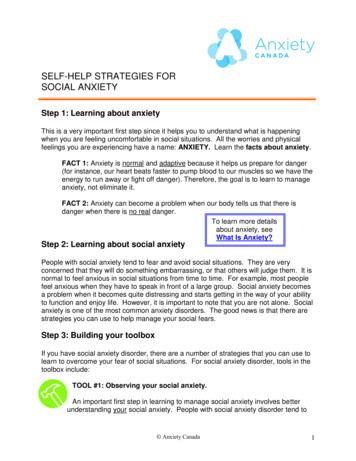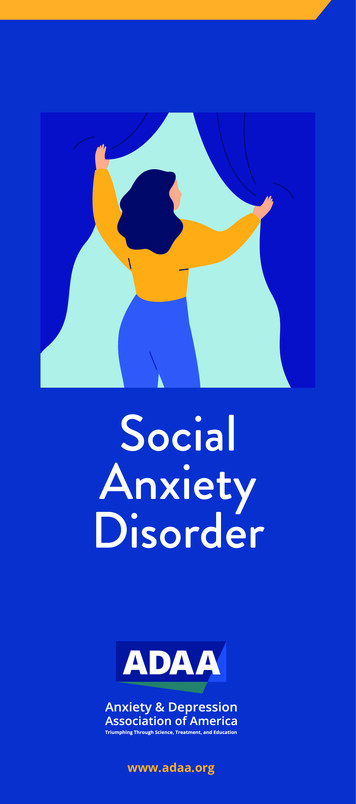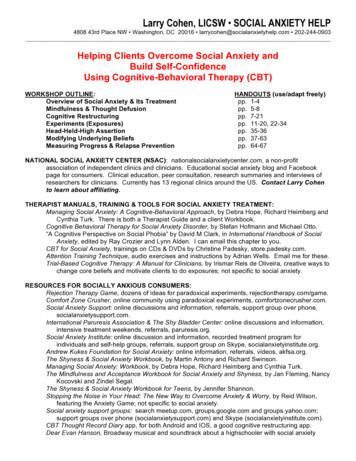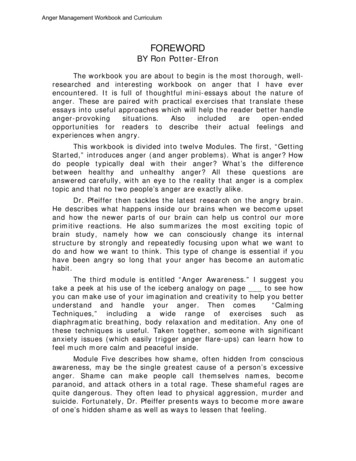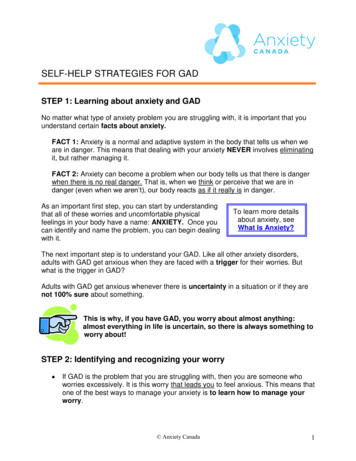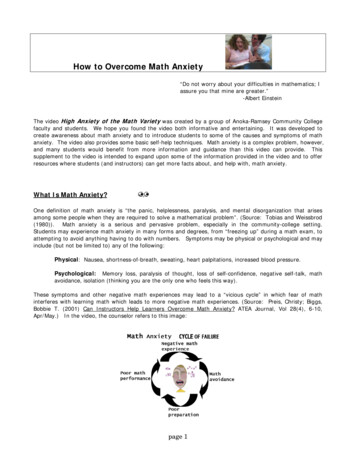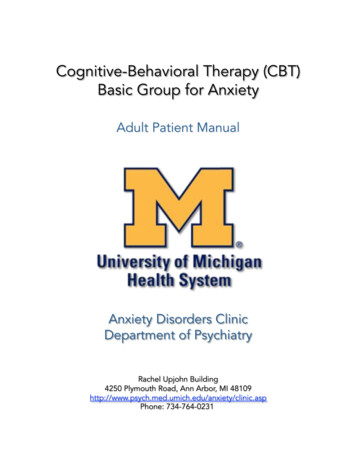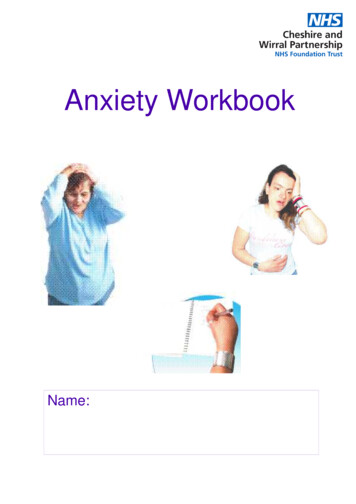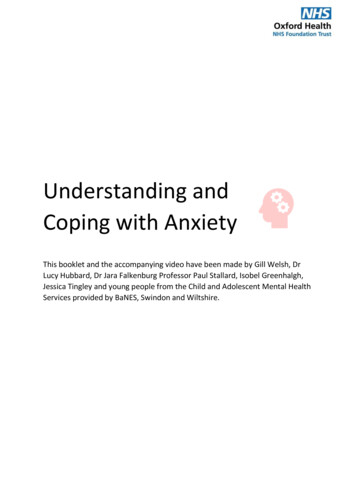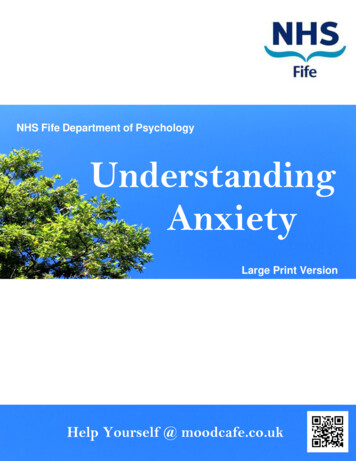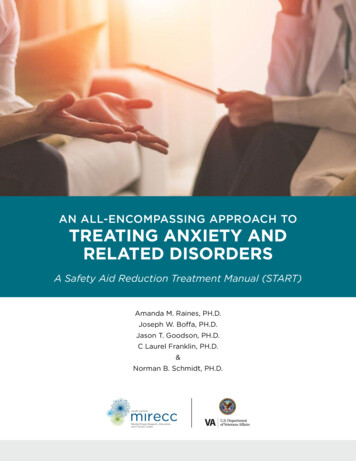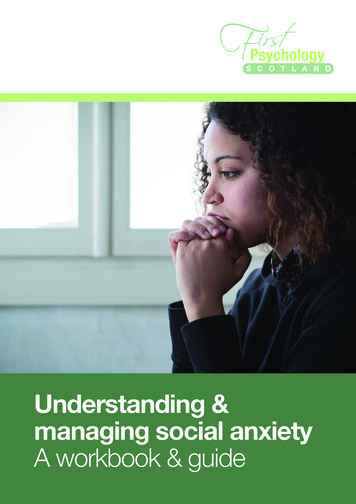
Transcription
Understanding &managing social anxietyA workbook & guide
An introductionDid you know that social anxiety is one of the most common anxiety disorders, affecting at least one in ten people inthe UK?When we struggle with social anxiety, daily tasks can feel distressing and this can hold us back from engaging in lifefully, for example it may hold us back in our careers, relationships, or hobbies and it can also lead to other healthissues including severe stress and depression.While a range of effective psychological and pharmacological treatments exist for social anxiety, many choose not tomake use of them, perhaps because the thought of accessing these services is in itself anxiety provoking. Sharingour personal feelings and struggles with others, even medical professionals such as GPs or therapists, can be tough!This booklet aims to reach those who are struggling with social anxiety and have not yet felt able to seek therapeuticservices. Or perhaps you have a friend or family member experiencing this at the moment. Whatever the reason, wehope you find it helpful and informative – and please do feel free to take it at your own pace!Not only will this booklet provide a wealth of information about social anxiety and how we can better understandit, but it will also provide some examples of techniques and activities that can be used to manage social anxietyeffectively.Page 1
Understanding social anxietyWhat does social anxiety feel like?It is completely natural for people to be sensitive to and give a greatamount of thought to social interactions with other people. However,social anxiety can be characterised by the movement of this helpfulawareness, into an unhelpful pattern of persistent fear and avoidance.Social anxiety involves experiences of anxiety or fear in social situations.This can include everyday activities that take place around other people,such as eating, drinking, or using a public toilet. In these situations, theindividual can feel humiliated or judged.Here are some examples of what social anxiety might feel like: Worrying about blushing in front of other peopleWorrying that what you are saying doesn’t make any senseWorrying that everyone is looking at youWorrying that people are thinking negatively towards youWhat is your experience of social anxiety?At times, social anxiety can feel such a strong fear to the individualexperiencing it that they feel unable to control it. As a result, they mayworry about certain events well in advance of them happening, and avoidany situation where there is a possibility of engaging in social interaction.Because of this avoidance behaviour, it is common for people with socialanxiety to become withdrawn, isolated, and depressed.Although there are various anxiety disorders, there are distinctive features ofsocial anxiety disorder that separate it from the rest.Physical signs Nausea and stomach pain or ‘butterflies’SweatingTremblingHeart palpitationsEmotional signs Feeling anxious or ‘on edge’Feeling vulnerableFeeling self-consciousFeeling embarrassedPage 2
Behavioural signs Avoiding social situationsRemaining in the background of social situationsStaying quiet in social situationsDrinking alcohol before a social situationWhat causes social anxiety?Past experiencesOne theory about how we develop social anxiety is that it is a result of ourpast experiences. For example, if we have felt embarrassed or humiliated ina previous social situation, we can worry or assume that a similar situationwill go the same way in the future. For this reason, we will often do whateverwe can to avoid finding ourselves in that situation again. Over time, this canincrease our fear of social situations, contributing to the maintenance of oursocial anxiety.Here are some examples of past experiences that may have influenced howwe experience social situations today: Previous history of bullyingHaving been involved in an abusive relationshipGrowing up with parents or family members who are very critical of usA social interaction in our past that left us feeling totally humiliatedand/or judgedUnhelpful thinking patternsAnother reason we may struggle to think of social interactions in a positivelight is because of negative or unhelpful thinking styles that we may havedeveloped.Page 3What signs of socialanxiety have younoticed in yourself?Write them downhere.
Here are some examples of unhelpful thinking patterns or ‘cognitivedistortions’ that we might experience in relation to social situations, ‘Mind-reading’ (e.g. “That person looked away while I was speakingwhich means they must think I am boring”)‘Prediction’ (e.g. “If I go to the party tonight, I will end up making a foolof myself”)‘Comparing and despairing’ (e.g. “They are so confident compared tome”)‘Shoulds’ and ‘musts’ (e.g. “I must be loud and make others laugh”)‘Catastrophising’ (e.g. “If I say the wrong thing, everyone will hate me”)Evolutionary factorsIt has also been suggested that some people may develop social anxietyas a result of evolutionary factors. Human beings are historically a sociablespecies that tend to thrive in the company of others. For this reason, it isunderstandable that people would fear upsetting others or not fitting in toa social group, leading to avoidance of situations when this could occur.People with social anxiety may be naturally more sensitive to negativeevaluation or have an increased awareness of the disadvantages this couldbring.Biological factorsBiological factors have also been recognised as potentially playing a partin social anxiety. For example, if someone in your immediate family issocially anxious, there could be a higher chance of similar personality traits.However, it is important to acknowledge the role of environment here andconsider that we may also learn these traits from others rather than inheritthem.In reality, it is likely that it is a combination of biological, social andenvironmental factors that play a role in the development of social anxiety.Although it is interesting to understand why we may be socially anxious,it is perhaps more useful to think about our own unique experiences ofsocial anxiety in more depth. It is important to recognise how it is negativelyimpacting our daily lives and to think about helpful ways in which we canmanage this.Reflecting on factors that may have contributed to our own social anxietycan help us better understand the issues we face and how we might heal.Page 4“People withsocial anxietymay be naturallymore sensitiveto negativeevaluationor have anincreasedawarenessof thedisadvantagesthis could bring.”
Managing social anxietyRecognising and challenging unhelpful thoughtsNegative and unhelpful thoughts can occur so quickly that it can be difficultto even recognise they are there. However, negative automatic thoughts(or ‘NATs’) can contribute to how we feel and behave when facing a socialsituation.Listed below are examples of some NATs that may come up for people withsocial anxiety: ‘I am going to make a fool of myself’‘People will laugh at me’‘What if they know I am anxious?‘People think I am weird’‘I need an escape route’‘I can’t do this’‘I am pathetic’Can you think of any NATs that might have come up for you in socialsituations? This will make you more likely to recognise them if they come upnext time!So what can you do when these thoughts do come up? Instead of acceptingthem as fact, it can help to remind yourself that they are not actually factual,but often unrealistic and unhelpful!To challenge these thoughts, there are some useful questions you can askyourself: Is there any evidence that contradicts this thought?Can you identify any of the patterns of unhelpful thinking describedearlier?What would your friend say to you if they knew what you werethinking?How do you think you will feel about this in six months?What are the costs and benefits of thinking in this way?Is there another way of looking at this situation?Page 5Write down any NATsthat you have noticedarising in your ownsocial situations.
ExampleChallengingyour NATsNAT: ‘I am going to make a fool of myself’Is there any evidence that contradictsthis thought?Answer: ‘I didn’t make a fool of myselflast week when I was socialising withfriends’Can you identify any of the patterns ofunhelpful thinking described earlier?Answer: ‘I can see that I used thecognitive distortion of ‘prediction’ here,which could be unhelpful.’What would your friend say to you if they knew what you were thinking?Answer: ‘They would tell me I will be fine and not to worry’How do you think you will feel about this in 6 months?Answer: ‘In six months, I will probably not be thinking about this anymore’What are the costs and benefits of thinking in this way?Answer: ‘This thought is making me worry a lot and is also very distracting. I am not sure what the benefit is’Is there another way of looking at this situation?Answer: ‘I could look at this social situation as something new and exciting. It is something I want to be a partof, but my negative thoughts have been preventing me from thinking about it this way’Alternative thought: ‘I am looking forward to this event, and have no reason to worry’Page 6
Behavioural experimentsBehavioural experiments can be another really helpful way to challenge ouranxieties. They allow us to work towards our goals in small, manageablesteps.This is something that can be done in therapy or individually. If you feelopen to the challenge, why not give this exercise a go!STEP 1: Identify the belief you would like to testWe tend to have hundreds of beliefs about ourselves going through ourminds when we think about upcoming social situations. Take a momentto think about some of the beliefs that come up for you. Here are somecommon examples that may help with this part:“If I eat in front of people they will think I’m disgusting”“If I make eye contact with people they will react negatively”“If I engage in conversation, people won’t be interested”You can choose your own experiments based on what feels comfortablefor you, starting with situations that are only a little uncomfortable, andgradually working on more difficult situations as you build self-confidence,one small step at a time!Page 7Write down a statementthat you would like totest.
STEP 2: Rate the beliefNext, write down how much you believe the statement above from 0 (not atall) to 100 (I believe it to be completely true).STEP 3: Plan an experiment that could test the beliefIf someone was to ask you how you knew that statement was true, howwould you respond?If they then asked you to prove it was true, how would you go about it?With these questions in mind, can you think of a way in which you couldtest the belief? Most of the time, we tend to avoid the situations that thesebeliefs are about, but continue to assume they are true.Think about what behavioural experiment you would like to try. Here aresome examples to give you some ideas: eat in front of another person when you would usually eat alonemake eye contact with people in a situation when you would usuallypurposefully look elsewhereengage in a conversation you would usually avoidAre there any obstacles you can foresee with this experiment? Location?Practicalities? Safety issues (you may wish to ask someone you trust tosupport you)?Page 8Think about anypotential obstaclesand whether there isa way around them orwhether an alternativeexperiment wouldwork better in thisinstance. For example,if in-person meetingsaren’t possible, couldyou carry out theexperiment virtually?
STEP 4: Go for it!It’s time to carry out the experiment now. This may require a lot of courageand belief in yourself. If you are struggling to feel motivated at this stage,remind yourself why you’re doing this, and how well you have done in justgetting to this stage!ReflectionsOnce you have completed an experiment, take the time to reflect on theoutcome and what your experience of the experiment was. Go back to step2 and re-rate your belief.YesNoRemember that whatever the outcome, you have successfully taken somepositive steps to challenge your anxieties and can continue to try this asmuch as you like. Well done!Page 9Has your rating of thisbelief changed? Tick theoutcome that applies toyour experiment.
Additional techniques to managesocial anxietyMindfulnessMindfulness is all about living in the present. When we experience socialanxiety, we can get caught up in distracting and disturbing thoughts andfeelings, usually making negative judgements and assumptions aboutourselves and our behaviour.By becoming more mindful, we can increase our awareness of thesethoughts and feelings, noticing them without judgement. In doing this, weare able to bring ourselves back into the moment, giving ourselves spaceto make valuable decisions about what course of action to take next.With the practice of mindfulness, we can learn to notice our socialdiscomfort and recognise any associated thoughts as merely thoughts, notfacts. With practice, we can learn to accept these thoughts as temporaryand passing, return to the present moment, and feel calmer and more incontrol.If you are interested in learning more about mindfulness, check out our‘Guide to Mindfulness’ booklet available on our website or have a lookonline for some user-friendly free apps that offer some mindfulness-basedexercises for you to lness-booklet.pdfSelf-compassionResearch has shown that self-compassion can be lower for those whoexperience social anxiety disorder, believed to be related to a greater fearof being evaluated.As we become more accepting of ourselves, the fear of being evaluatednegatively is likely to decline. Treating ourselves kindly allows us to feelsafe and connected instead of alone and isolated. Self-compassion canactivate the parasympathetic nervous system and dampen the sympatheticnervous system, which is the part responsible for the ‘fight or flight’reaction we might experience in social situations!For more information on self-compassion and how to incorporate it intoyour own life, have a look at our booklet, which can also be found on ourwebsite passion-booklet.pdfPage 10Self-compassion can be lower inthose who experience social anxiety
What next?Now that you’ve completed our booklet, we hope you have found it ahelpful tool towards understanding and managing social anxiety. Youcan always come back to this resource if you are looking to refresh yourmemory on any of the topics discussed.Alternatively, you might now feel that speaking to a professional about yoursocial anxiety would be a helpful next step. Remember that it is not a stepyou have to take alone. You can always ask someone you trust to comealong with you to the first session, or even to support you in making thatfirst call.If this sounds like something you might feel ready to do, feel free to contactus with any questions you have about this process, and we will be morethan happy to offer our expertise.Our highly qualified and experienced team at FirstPsychology Scotland offers a variety of therapy servicesand works with people with a wide range of issues andproblems.We provide: Therapy and coaching services for women, men,couples, children, young people and families. Employee counselling, CBT & psychological therapies;promotion of wellbeing in the workplace; andrehabilitation and personal injury support.All First Psychology practitioners have excellentqualifications and experience, so you can come to usknowing that you will see an experienced professional.Page 11
First Psychology Scotland offers:Therapy & coaching services for women, men,couples, children, young people & families.Employee counselling, CBT & psychological therapies;promoting wellbeing in the workplace; and rehabilitationand personal injury support.Aberdeen Borders Dundee Edinburgh Glasgow Inverness Perthand also OnlineTel: 0845 872 1780Email: info@firstpsychology.co.ukWeb: www.firstpsychology.co.uk First Psychology Scotland
social anxiety can be characterised by the movement of this helpful awareness, into an unhelpful pattern of persistent fear and avoidance. Social anxiety involves experiences of anxiety or fear in social situations. This can include everyday activities that take place around other pe
